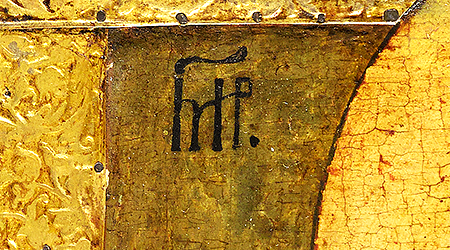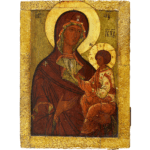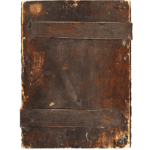A traditionally painted icon showing the Mother of God holding the Christ Child with her left hand and raising her right in blessing. Christ is slightly inclined towards his Mother, his right hand is raised in benediction, while his left hand is holding an unfurled scroll. The Mother of God is depicted wearing a dark maphorion with Bethlehem stars on her head and shoulders, the Infant Christ is dressed in a white ornamented chiton and an ochre himation. The icon is painted against a moss green ground, Greek letters MP ΘΥ and IC-XC in the upper part of the icon denote the Mother of God and Jesus Christ.
The Greek word Hodegetria (Ὁδηγήτρια) literally translates as ‘She who shows the Way‘. The Mother of God is shown holding the Christ Child and pointing towards Him as the source of salvation for mankind. The lost original of the Hodegetria was believed to have been painted from life by Luke the Evangelist. It was brought from Jerusalem to Constantinople in the 5th century and housed in the Monastery of Hodegon. Later on, the image was reproduced in numerous copies, the earliest one dates to the 6th century.
In Russian tradition, it is believed that in the 10th or 11th century the original Hodegetria made its way to Smolensk, where it was placed in the Assumption Cathedral. The icon became of the most venerated in Russia. Her feast day is celebrated on August 10th.













